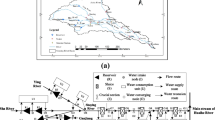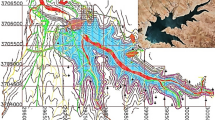Abstract
Water quality impairment is a serious health concern for reservoirs; two strategies were used to control reservoir outflow quality: (1) control of reservoir inflows with implementation of structural best management practices (BMPs) at the watershed, and (2) management of reservoir outflows by reservoir operational strategy. To assess the effectiveness of two strategies on reservoir water quality, an extension of the Sustainability Index (SI) for water quality was defined. Additionally, a quantity-based SI for supplying of downstream water demands was defined. So il and water assessment tool was linked to a reservoir simulation model (CE-QUAL-W2), and coupled with multi-objective particle swarm optimization algorithm. The proposed model was applied in four different scenarios on Alavian reservoir and its watershed, in Iran, during a 6-year time horizon. Four BMPs, named detention ponds, filter strips, parallel terraces, and grade stabilization structures, were used. The results indicated that application of the proposed approach provides the best set of solutions for decision makers to manage outflow quality and quantity. Whenever the watershed management strategy is not possible/practical, the reservoir operational strategy in selective withdrawal scheme would improve reservoir outflow quality by up to 77%. On the other hand, when the reservoir downstream water demand satisfaction is necessary, the watershed management strategy, or selective withdrawal scheme would be improved when the reservoir outflow dissolved oxygen concentration SI by up to 30 and 52%, respectively. Among the applied BMPs, filter strip had more effect on reducing nutrient loads and it was the most chosen BMP.















Similar content being viewed by others
References
Abbaspour KC, Yang J, Maximov I, Siber R, Bogner K, Mieleitner J, Zobrist J, Srinivasan R (2007) Spatially distributed modeling of hydrology and water quality in the prealpine/alpine Thur watershed using SWAT. J Hydrol 333:413–430
Alami MT, Abbasi H, Niksokhan MH, Zarghami M (2018) Charged system search for optimum design of cost-effective structural best management practices for improving water quality. Int J Optim Civil Eng 8(2):295–309
Arabi M, Govindaraju RS, Hantush MM (2006) Cost-effective allocation of watershed management practices using a genetic algorithm. Water Resour Res AGU 42:1–4
Arabi M, Frankenberger JR, Engel BA, Arnold JG (2008) Representation of agricultural conservation practices with SWAT. Hydrol Process 22(16):3042–3055
Arnold JG, Srinivasan R, Muttiah RS, Williams JR (1998) Large area hydrologic modeling and assessment—part 1: model development. J Am Water Resour Assoc 34(1):73–89
Aydin AY, Mays LW, Schmitt T (2014) Technical and environmental sustainability assessment of water distribution systems. Water Resour Manag 28:4699–4713
Castelletti A, Yajima H, Giuliani M, Soncini-Sessa R, Weber E (2014) Planning the optimal operation of a multi-outlet water reservoir with water quality and quantity targets. J Water Resour Plan Manag 140(4):496–510
Ciou ShK, Kuo JT, Hsieh PH, Yu GH (2012) Optimization model for BMP placement in a reservoir watershed. J Irrig Drain Eng ASCE 138(8):736–747
Coello AC, Pulido GT, Lechuga MS (2004) Handling multiple objectives with particle swarm optimization. IEEE Trans Evol Comput 8(3):256–279
Cole TM, Wells SA (2015) CE-QUAL-W2: A Two-dimensional, laterally averaged, hydrodynamic and water quality model, version 3.72 user’s manual. US Army Corps of Engineers, Washington, DC
Dalilsafaee S, Niksokhan MH, Moshtaghi B (2018) Impact of climate change on basin hydrological characteristics and thermal structure of reservoirs. Irrig Drain 67:306–322
Dhar A, Datta B (2008) Optimal operation of reservoirs for downstream water quality control using linked simulation optimization. Hydrol Process 22:824–853
Hashimoto T, Stedinger JR, Loucks DP (1982) Reliability, resiliency, and vulnerability criteria for water resource system performance evaluation. Water Resour Res 18(1):14–20
Houser J, Hauck L, Saleh A (2015) Modifying and validating the SWAT model to determine landuse effects on watershed water quality: using a dual level of model performance based on subbasin size. Int J Environ Res 9(3):885–896
Imani S, Niksokhan MH, Jamshidi S, Abbaspour K (2017) Discharge permit market and farm management nexus: an approach for eutrophication control in small basins with low-income farmers. Environ Monit Assess 189:346. https://doi.org/10.1007/s10661-017-6066-4
Kaini P, Artita K, Nicklow JW (2012) Optimizing structural best management practices using SWAT and genetic algorithm to improve water quality goals. Water Resour Manag 26:1827–1845
Kamali A, Niksokhan MH (2017) Multi-objective optimization for sustainable groundwater management by developing of coupled quantity-quality simulation-optimization model. J Hydroinform 19(6):973–992
Karamouz M, Taheriyoun M, Baghvand A, Tavakolifar H, Emami F (2010) Optimization of watershed control strategies for reservoir eutrophication management. J Irrig Drain Eng ASCE 136(12):847–861
Kennedy J, Eberhart RC (1995) Particle swarm optimization. In: Proceedings of the IEEE international conference on neural networks, vol. IV, Perth, Australia, pp 1942–1948
Kim H, Li M, Kim J, Jaber F (2016) Examining the impact of suburbanization on surface runoff using the SWAT. Int J Environ Res 10(3):379–390
Loucks DP (1997) Quantifying trends in system sustainability. Hydrol Sci 42(4):513–530
Mahab Ghodss Consulting Engineering Company (MG) 1990 Report of Alavian dam project. Tehran, Iran (in Persian)
Maringanti C, Chaubey I, Arabi M, Engel B (2008) A multi-objective optimization tool for the selection and placement of BMPs for pesticide control. Hydrol Earth Syst Sci 5:1821–1862
Moriasi DN, Arnold JG, Van Liew MW, Bingner RL, Harmel RD, Veith TL (2007) Model evaluation guidelines for systematic quantification of accuracy in watershed simulations. Trans Am Soc Agric Biol Eng 50(3):885–900
Moshtaghi B, Niksokhan MH, Ghazban F, Dalilsafaee S (2018) Assessing the impacts of climate change on the quantity and quality of agricultural runoff (case study: GOLGOL river basin. Irrig Drain. https://doi.org/10.1002/ird.2211
Motovilov YG, Gottschalk L, Engeland K, Rodhe A (1999) Validation of distributed hydrological model against spatial observations. Agric For Meteorol 98:257–277
Oxley RL, Mays LW, Murray A (2016) Optimization model for the sustainable water resource management of river basins. Water Resour Manag 30:3247
Saadatpour M, Afshar A, Edinger JE (2017) Meta-model assisted 2D hydrodynamic and thermal simulation model (CE-QUAL-W2) in deriving optimal reservoir operational strategy in selective withdrawal scheme. Water Resour Manag 31(9):2729–2744
Sandoval-Solis S, McKinney DC, Loucks DP (2010) Sustainability index for water resources planning and management. J Water Resour Plan Manag 137(5):381–390
Singh A (2014) Simulation and optimization modeling for the management of groundwater resources. II: combined applications. J Irrig Drain Eng 140(4):04014002
Soleimani S, Bozorghaddad O, Saadatpour M, Loáiciga H (2016) Optimal selective withdrawal rules using a coupled data mining model and genetic algorithm. J Water Resour Plan Manag 142(12):04016064
Srdjevic Z, Srdjevic B (2017) An extension of the sustainability index definition in water resources planning and management. Water Resour Manag 31:1695
Wang S (2005) An integrated modeling approach to total watershed management: water quality and watershed assessment of Cheney reservoir, Kansas, USA. Water Air Soil Pollut 164:1–19
Wu J, Yu S, Zou R (2006) A water quality-based approach for watershed wide BMP strategies. J Am Water Works Assoc 42(5):1193–1204
Yazdi J, Moridi A (2017) Interactive reservoir-watershed modeling framework for integrated water quality management. Water Resour Manag 31(7):2105–2125
Yilmaz B, Harmancioglu NB (2010) Multi-criteria decision making for water resource management: a case study of the Gediz river Basin, Turkey. Water SA 36(5):563–576
Author information
Authors and Affiliations
Corresponding author
Rights and permissions
About this article
Cite this article
Aalami, M.T., Abbasi, H. & Nourani, V. Sustainable Management of Reservoir Water Quality and Quantity Through Reservoir Operational Strategy and Watershed Control Strategies. Int J Environ Res 12, 773–788 (2018). https://doi.org/10.1007/s41742-018-0130-y
Received:
Revised:
Accepted:
Published:
Issue Date:
DOI: https://doi.org/10.1007/s41742-018-0130-y




